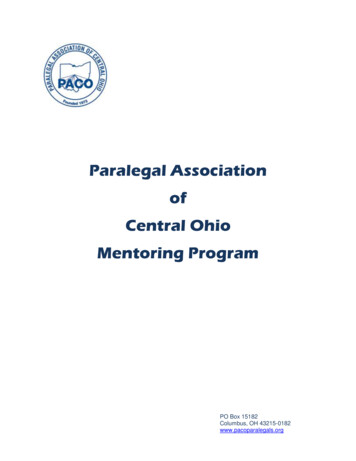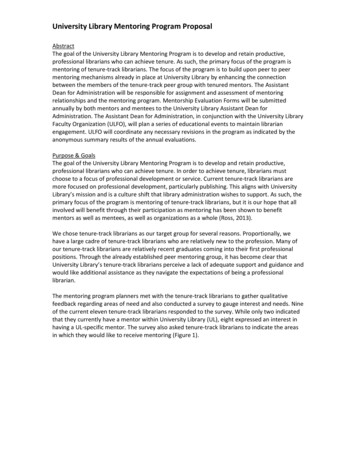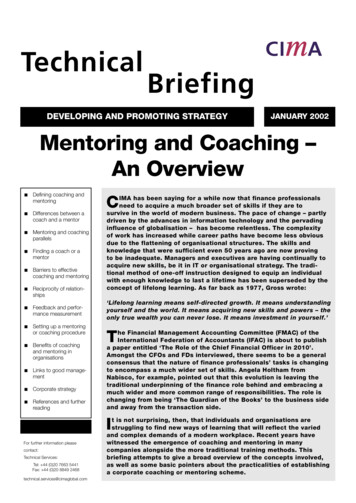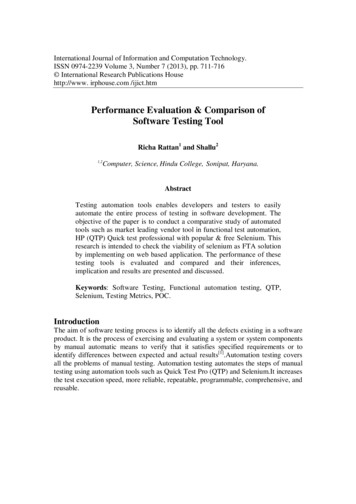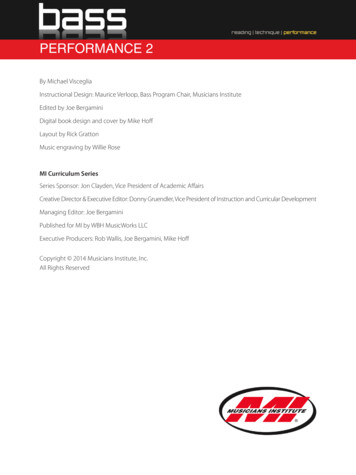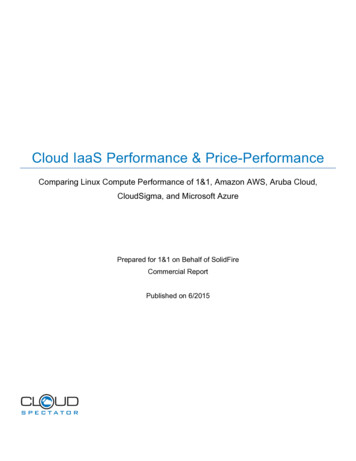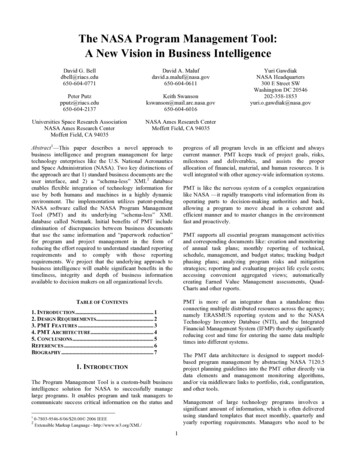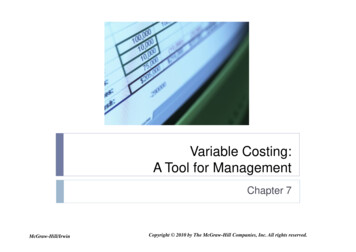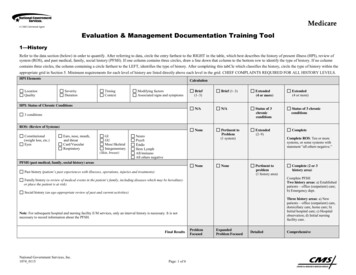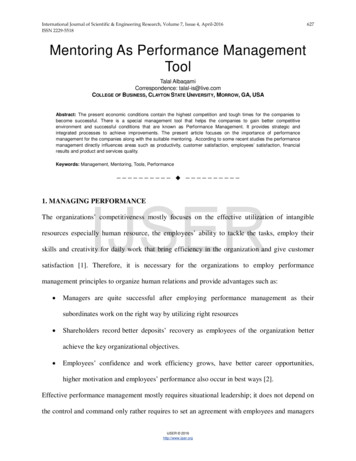
Transcription
International Journal of Scientific & Engineering Research, Volume 7, Issue 4, April-2016ISSN 2229-5518627Mentoring As Performance ManagementToolTalal AlbaqamiCorrespondence: talal-is@live.comCOLLEGE OF BUSINESS, CLAYTON STATE UNIVERSITY, MORROW, GA, USAAbstract: The present economic conditions contain the highest competition and tough times for the companies tobecome successful. There is a special management tool that helps the companies to gain better competitiveenvironment and successful conditions that are known as Performance Management. It provides strategic andintegrated processes to achieve improvements. The present article focuses on the importance of performancemanagement for the companies along with the suitable mentoring. According to some recent studies the performancemanagement directly influences areas such as productivity, customer satisfaction, employees’ satisfaction, financialresults and product and services quality.Keywords: Management, Mentoring, Tools, Performance—————————— ——————————IJSER1. MANAGING PERFORMANCEThe organizations’ competitiveness mostly focuses on the effective utilization of intangibleresources especially human resource, the employees’ ability to tackle the tasks, employ theirskills and creativity for daily work that bring efficiency in the organization and give customersatisfaction [1]. Therefore, it is necessary for the organizations to employ performancemanagement principles to organize human relations and provide advantages such as: Managers are quite successful after employing performance management as theirsubordinates work on the right way by utilizing right resources Shareholders record better deposits’ recovery as employees of the organization betterachieve the key organizational objectives. Employees’ confidence and work efficiency grows, have better career opportunities,higher motivation and employees’ performance also occur in best ways [2].Effective performance management mostly requires situational leadership; it does not depend onthe control and command only rather requires to set an agreement with employees and managersIJSER 2016http://www.ijser.org
International Journal of Scientific & Engineering Research, Volume 7, Issue 4, April-2016ISSN 2229-5518628in which employees commit providing their best performance in achieving commonorganizational goals with the management support. Performance management involves BalancedScorecard methodology to evaluate the employees’ performance by regulating effectivecommunication to know which extent human capital has achieved the highest corporateobjectives under the supervision of their managers. Therefore, many companies have usedperformance management tools to evaluate the right performance measurement and issues thatemployees face showing better working efficiency [3].2. PERFORMANCE MANAGEMENT TOOLSAccording to Armstrong [4] main performance management tools are feedback, mentoring,IJSERinterpersonal communication, coaching, and counseling. These tools are used to improve workperformance of those employees who feel unable to meet the company’s requirements andmanagers’ expectations. Following two performance management tools are widely used inalmost every large and medium-sized enterprise [5].3. COACHINGIt usually involves an individual who is concerned to help an employee who must be talented orhave some guts to seek information that his coach is giving to him. It helped the employees toimprove their present capabilities and skills and refined them to show the best performance. It isalso an important tool that is used in talent management. Organizations can employ it in differentways on different occasions such as when an employee has to confer a new task, or someresponsibility is given to the employee, then he must approach his coach or company has toprovide coaching to understand the requirements of the new position and responsibility. For thisIJSER 2016http://www.ijser.org
International Journal of Scientific & Engineering Research, Volume 7, Issue 4, April-2016ISSN 2229-5518629purpose, companies can take help from the existing experienced employees or hire best leaderswho realize the employees about their work and stimulate their thinking to enhance the workefficiency. The managers and leaders have to continuously encourage the employee to thinkabout the problems and to look for a better solution. The managers’ encouragement works like aspur that indulges confidence in the employees over his capabilities, and he works hard to meethis manager’s expectations. It is an interactive process in which managers’ work is to evadeemployees’ faults by teaching them better skills. They forward knowledge in employees andinstill values and work demands among them. Best coaching skills conduct the best performance,higher motivation and work satisfaction. It develops best working relationships betweenemployees and managers [6].IJSER4. MENTORINGThe second most important performance management tool is mentoring. Mentoring is a processthat develops among two individuals who assess each other’s issues and provide the best solutionto cover the problems and to enhance performance by continuously watch and gives feedbackon the work. A mentor can use several scale and styles to support growth, provide feedback,source of information, provide opportunities, personal development and find a pattern to followand to reach to the organizations. The cooperation is the main component of mentoring that mustprevail among the mentor and his mentee.5. STYLES AND APPROACHES USED BY MENTORIJSER 2016http://www.ijser.org
International Journal of Scientific & Engineering Research, Volume 7, Issue 4, April-2016ISSN 2229-5518630Mentors use a directive approach that provide feedback, suggest a solution, provides step by stepinstructions and open leading. The mentor directly stimulates mentees by facing challenges adimproving their performance during work [7].Comparison between mentoring and coaching [5]CoachingProblemsContextMentoringarerelatedtothe Problems are linked with the personality,performance, work, and tasksa coach can be a trainer and line UsuallyRelationshipExpertisework and careeraseniororexperiencedmanageremployees of the companyIt is not necessary the coach mustMentor must have sufficient knowledgeIJSERbe experienced in the area in which and experience for which he is mentoringhe is providing coaching.Approachthe employeeCoach has an approach to attaining Mentors leads to bigger defectiveness,new goals and work to find enable mentee to seek from the mentor’ssolutionsexperienceMeetings frequencyAccording to the set schedulesRely on the needs of the menteesContent and natureFocus on attaining advancementsPossess informal discussion related to theof meetingsand agreed goalscareer, personal and work issuesArrangementmostly when required objective Providesand goals are achievedlong-termproblemssuchas during career counseling6. CONCLUSIONThe human capital work performance helps the organizations to come out of the criticalsituations and to achieve their goals. The goals can be reached in more organized manner andIJSER 2016http://www.ijser.org
International Journal of Scientific & Engineering Research, Volume 7, Issue 4, April-2016ISSN 2229-5518631improved performance. The management of performance helps the managers to overcome theemployees’ faults and improve their work efficiency, by following certain tools. Two importanttools are discussed in this article, mentoring and coaching that are widely used and moreeffective to enhance employees’ capabilities, skills and work efficiency by inducing advancedknowledge and encouragement.REFERENCES[1]. Uddin, M. J., Luva, R. H., & Hossian, S. M. M. (2013). Impact of organizational culture onemployee performance and productivity: A case study of telecommunication sector inBangladesh. International Journal of Business and Management, 8(2), 63.IJSER[2]. Mayer, R. C., & Davis, J. H. (1999). The effect of the performance appraisal system on trustfor management: A field quasi-experiment. Journal of applied psychology, 84(1), 123.[3]. Carmen, A. (2014). Management by Objectives. Ovidius University Annals, EconomicSciences Series, 14(1), 433-436.[4]. Armstrong M., 2006, Performance management, Kogan Page, London.[5]. Vodak, J. (2007) Mentoring – Performance Management Tool, Zilina University[6]. Pedler, M. M. (2012). Action learning for managers. Gower Publishing, Ltd.[7]. Tillema, H., & Van Der Westhuizen, G. J. (2015). Mentoring conversations and studentteacher learning. In Mentoring for Learning (pp. 23-45). SensePublishers.IJSER 2016http://www.ijser.org
According to Armstrong [4] main performance management tools are feedback, mentoring, interpersonal communication, coaching, and counseling. These tools are used to improve work performance of those employees who feel unable to meet the company’s requirements and managers’ expectations. Following two performance management tools are widely used in

